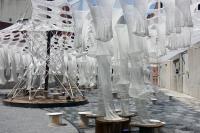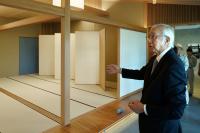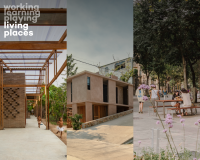Foucart
Oostduinkerke, België
The plot of land borders with the Spelleplekkeduinen - Plaatsduinen, one of the largest and biologically valuable dune complexes (260 ha) on the Belgian coast. The house with its unique location is designed by Jean-Jules Eggericx (1884-1963), an architect who is considered one of the leading contemporary Belgian architects.
The house dates from the 1930s which could imply that it was built at the start of the Duinpark development.
On one hand, the terminus a quo implies that the existing house, in its current state, kept its visual appearance as much as possible.
On the other hand, it is to tackle the detached volume - with a sloping roof which was added in the 1960s - in a way so that the renovated end result does not detract from the appearance and perception of the house.
On the contrary, the renovated end result, means an added value for the existing house.
The volume of the added above-ground extension is identical to the volume of the pre-existing, now demolished, outbuildings.
It’s the pursuit of the design, detailing both volumes - one subordinate to the other - with the help of the dunes to string it all together, just as if it has always been there.
The purpose of bringing a house that is situated on the edge of an allotment - on top of a dune - as if it was surrounded, in the middle of the dunes.
The existing contour lines of the dunes were raised where necessary to allow circulation and avoid 'auto pollution', which again, reinforces the feeling of living in the middle of the dunes. The ‘alien’ vegetation would give way to typical ones - local dune vegetation such as: beach grass / willow dunes / sea buckthorn and a strategic implantation of 1 maritime pine.
Considering the extremely poor physical condition, the existing house - with the exception of the foundation, basement and roof plates - were completely renovated.
Because of the large staircase, there were two useless rooms on the first floor - too small to even get a bed in there. By installing: a new staircase, a small home elevator, and getting rid of all the walls - the floor could be converted into a master bedroom. To make it autonomous, the top floor of 13 m2 (31m3) was extended with an ensuite bathroom. It is a massive extension as it thickened the existing roof partition wall. The unused roof became a roof terrace - adjacent to the master bedroom - with a beautiful panoramic view over the dunes..
To meet the demand of the client- who found the ceilings of the living space too low - we lowered the floor plate. However, seen from the outside, nothing changed in the exterior of the house.
To fortify the unity with its surroundings, sand-colored concrete floors were provided both inside and outside, bringing the dunes inside the house.
Some windows were strategically added here and there and some were left out. Wooden shutters were replaced by wooden sliding hatches.
In the new "outbuilding" - to replace the one from 1966 - a garage, outdoor pool, small gym, changing room, and necessary storage facilities were added.
The garage, which has a direct connection to the lift, has been hidden "in the dune".
A sand-colored swimming pool was integrated in the roof slab of the new outbuilding, leveled with the terrace of the existing house.
The raised ledges around the pool hide the pool from its surroundings, providing the necessary privacy but also serve as a “fall protection” and necessary "sand barrier" from the dune area.
The massive low horizontal walls - with a rounded, solid finishing - are very much in keeping with the architecture of the house, and form a subtle part of the Decorum seen from the dunes, like a bunker remnant.
All while trying to preserve the soul of the place, how I experienced it during my first visit. On the inside of the longest wall alongside the pool, an artwork by Philip Y Aguirre has been integrated. A subtle, sensitive picturethat continues underwater. Visible fragmentarily from the main living and sleeping space of the house, invisible to the outside world.
At the end of the pool, above the garage - slightly higher - a small airy / closable frameless glass overhang has been provided. An ideal place - sheltered from the wind - with a beautiful view over the dune area / the house and the swimming pool with integrated artwork. An ideal place to rest, to exercise, or by sliding shut a "cylindrical" curtain – to change.
At the junction of the existing home linking the new outbuilding, an "outside fireplace" was built. Underneath the fireplace is a window, which brings daylight and air into the underlying shower, washing and drying area. The back of the fireplace is a glass plate, so that while swimming you can see the open fire – creating a real holiday feeling.
- Architecten
- De Bruycker – De Brock
- Locatie
- Oostduinkerke, België
- Jaar
- 2020























